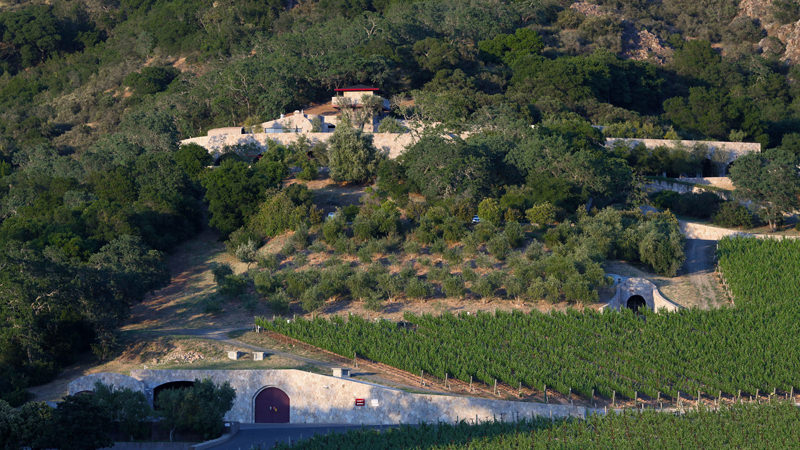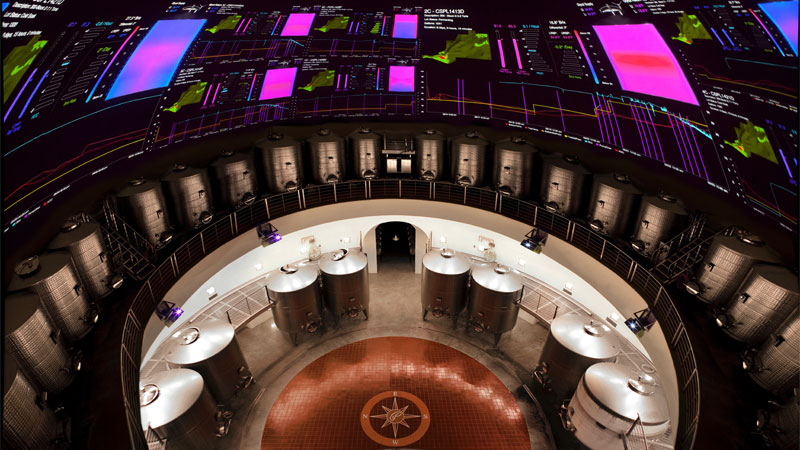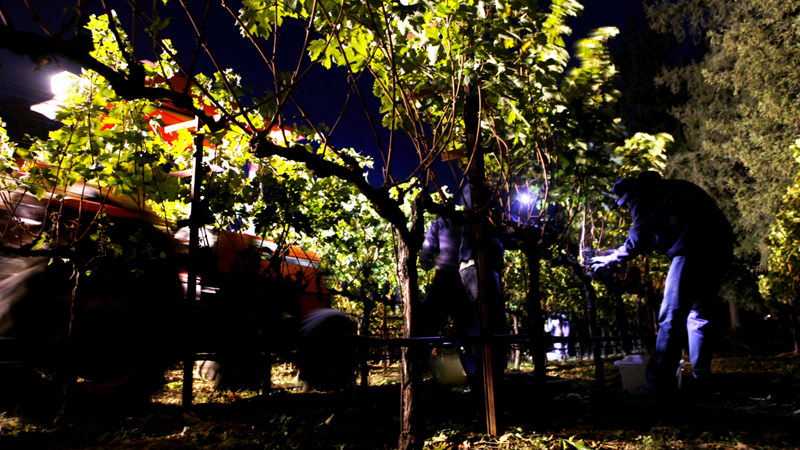This month, VinePair is exploring how drinks pros are taking on old trends with modern innovations. In Old Skills, New Tricks, we examine contemporary approaches to classic cocktails and clever techniques behind the bar — plus convention-breaking practices in wine, beer, whiskey, and more.
Grapes are a hardy, resilient fruit. Among the first lessons one learns when studying wine is that grapes should even undergo stress during their time on the vine when grown for high-quality winemaking. And so we can describe the wine industry as characteristically resilient by nature: resistant to freak annual weather occurrences; resistant in the long run to the fickle tides of drinking trends; and resistant, largely, to technological advancements.
The basic winemaking formula has remained more or less unaltered in its 8,000-odd-year history: Humans pick grapes from the vine, then crush them to release a saccharine juice, or “must.” In the vital act of transubstantiation for those who worship at the altar of inebriation, yeast then converts the sugars present in this solution to alcohol. Then, after an optional period of aging, the maker transfers the finished wine to a watertight and ideally inert vessel where it waits to render its drinker sensorially stimulated and reaching for a second sip.
Don’t miss a drop!
Get the latest in beer, wine, and cocktail culture sent straight to your inbox.
That Georgian producers continue their millenia-old tradition of making skin-contact qvevri wines, or that American natural winemakers are reviving the thrifty Roman technique of making piquette, is not only acknowledged in the wine world, it’s actively celebrated. Meanwhile, in Western Europe, vaunted wine estates boast multi-generational ownerships — bodies of knowledge and expertise handed down from century to century. But as the world advances and digitizes by the second, where does technology fit into wine? Based on the above examples, it doesn’t.
Of course, not all wine producers are entirely resisting the changing world around them. While some have embraced broad-scale mechanization in the vineyard and winery, others have gone to more extreme lengths. The world’s highest- tech producers are turning to capital-B Big data and computer science; they’re harnessing sorting tables that analyze grapes on a three-dimensional level; and they’re designing every aspect of their vineyards and winemaking facilities so that their wines will arrive in bottle with a predetermined style.
One producer stands above all on this stage: Napa Valley’s Palmaz Vineyards. Palmaz’s end goal and, the producer might argue, most significant achievement is not revolutionizing what wine is, but utilizing impossibly forward-thinking technology to craft a product that is almost imperceptibly different from other big, bold Napa wines. In an industry that glorifies ancient methods and craftsmanship, why go to such technological lengths to eliminate much of what the winemaking world considers integral to wine?
Is a winery’s pursuit of perfection — its quest to stamp out every flaw that may arise on a grape’s journey from vineyard to bottle — ultimately worth it if it risks losing the intangible romanticism of traditional winemaking? Or is that very argument just a cleverly calculated concept, conceived to excuse the industry’s inertia?
Isolating the Variables
One might be tempted to describe Palmaz Vineyards as being nestled on top of Coombsville’s Mount George, only the winery is largely located inside rather than on top of the mountain. The gentle nature of the verb “nestle” also does little justice to the gargantuan three-city-blocks-deep, 18-story-tall space housing the facility. Had it been carved by hand, it would have required a chisel so large only Thor could yield it.
The exact dimensions of Palmaz’s facility, as with every aspect of the estate’s operation, are far from arbitrary, as I soon learn when talking with the winery’s co-founder, Christian Gastón Palmaz.
Like many of its neighbors, Palmaz focuses mainly on Bordeaux varieties. The property’s 64 acres of vineyards are planted to the famed French region’s five main red grapes, as well as three whites and a smattering of Grenache. From the valley floor to up and over the tip of Mount George, the vineyards experience the unique microclimates of three distinct elevations while their roots dig deep into a diverse range of unique soils.
“In our mind, this property was begging for a winery that could isolate the variables,” Palmaz says. “If you think about all of these factors as colors on a palette, the ultimate winery is one that gives the winemaker as many colors as possible when it’s time to paint.”
In simple terms, the philosophy requires enough fermenters for every one of the estate’s parcels — 24 to be exact. But nothing is simple at Palmaz; every aspect of viticulture and vinification has been specifically designed to uphold the integrity and maintain the identity of each plot, before each finished wine is considered for a place in the final blend.

Free-Falling Tannins and Gravity Flow
Now back to that gigantic winery in the mountain. Palmaz commissioned its construction with the notion of gravity flow in mind. Picked grapes arrive at the building’s highest point — one of only two parts visible from the exterior — then flow down the structure, going through various stages of vinification, maturation, and blending before they eventually emerge from the “ground floor” in shiny bottles.
The winery’s vertical nature is not just some labor-saving sleight of hand. Its design boils down to wine’s texture. Palmaz explains that during the late ‘80s, scientists discovered something about tannins that gained little reporting outside of the academic space.
Previously, the general understanding was that red wines became silkier, softer, and smoother as they aged because tannins were “falling” out of the liquid. But rather than becoming less tannic, scientists then learned that the texture-giving molecules found mainly in reds would change in structure over time, transforming from hundreds of tiny individual components into multi-chain polymers. The larger the chain, the softer their impact on the palate. And just as importantly, the longer their staying power.
“These complex, delicate chains of polymers are really easy to break,” Palmaz explains. “In the late ‘80s, this new philosophy emerged that said ‘maybe, as an industry, we should be really gentle with the wines while we’re making them so that we can promote this polymerization.’”
Palmaz’s solution, therefore, was to design a space where production was interrupted only by gentle movements. “We decided to build a winery that would have zero compromise in the gravity-flow story, even at bottling,” he says.
All-Seeing Supercomputers
Focusing on gravity flow is not unique to Palmaz, and humans have long since surpassed 18 stories of construction. But it’s in the winery, as well as in and above its vineyards, where Palmaz implements the cutting-edge of technology. To list each of its advancements would require the space and words typically only afforded to works of academia — and no one reads those, apparently. So we’ll hone our focus on only the truly remarkable, of which there are still many factors to mention.
When grapes arrive at the facility’s uppermost level, a machine Palmaz describes as a 10-finger nomadic de-stemmer gently frees them from their bunches. Like personal belongings at JFK, the fruit travels onto a second inspection table via a conveyor system, then passes through a third and final device used for the initial stages of analysis.
Armed with a “four-axis vision system,” the equipment considers each grape’s size, shape, color, and texture using a 3D stereoscopic camera. With the aid of an advanced AI algorithm, the machinery rapidly identifies the fruit, while 248 puffer air jets ensure anything that doesn’t meet the winery’s standards will not make it to the next stage of the journey. “We used to do this all by hand,” Palmaz says, an almost lamenting tone to his voice. “This system is infallible. It’s becoming the gold standard of optical sorting for fruit.”
From here, gold-standard grapes make their way into one of 24 fermenters custom-designed for their specific parcel. Those vessels sit atop a rotating circular carousel, which is housed inside a 77-by-55-foot dome that could be mistaken for a planetarium. On the interior roof of this dome, however, one will find not the constellations of Orion or Pegasus but real-time data fed from the fermentation vessels.
Each pharmaceutical-grade fermenter contains five independent heating and cooling zones and is hooked up to and controlled by a machine-learning, AI-assisted computer program that the data science graduate Palmaz helped design. It’s called FILCS, which stands for Fermentation Intelligence Logic Control System and is pronounced “Felix.” (For purely stylistic purposes, we’ll continue with the phonetic spelling from here on.)

Felix monitors the activity of fermentation based on the speed that sound travels through the liquid, then adjusts the temperature accordingly to ensure the process’s overall “health” is maintained. Palmaz is quick to emphasize that last part, noting that the system’s overarching purpose is to relay data and provide the optimal conditions for the four strains of yeast used for fermentation.
It’s up to the winemakers — Palmaz hasn’t done away with those just yet — to make all decisions regarding the style and profile of the final wine. “It’s a biological baton race, and it’s really complicated to manage,” he says. “Wine is incredible: It’s grape juice on day one, and it’s wine by day 12. The transformation in aromatics is like steering a ship through stylistic waters. The winemaker needs to be there the moment something great happens. And what do they want in hand? Do they want a hydrometer and a graduated cylinder? No, they want a glass.”
At no point will Felix tell Palmaz executive winemakers Mia Klein and Tia Mitchell, “Hey, I think this juice is tasting pretty good right now.” Instead, it communicates messages along the lines of: “Based on statistical probability, in 92 hours and 14 minutes, you may be heading into a period that you told me prior contributed to an oxygen deficiency.” Mercifully, Klein and Mitchell are well versed in this tongue.
By the time the wine is finally ready for bottling, it will have aged in fine French oak on multiple different levels throughout the facility. Blending takes place on the same level as the dome, to which the barrels are transported via special elevators. From a location 133 feet above the bottling line, the wine will gain enough pressure as it flows from blending tanks to the packaging facility to allow for filtration and bottling using the assistance of nothing other than gravity.
All-Seeing Cessnas
At this point, we should zoom out and recognize that, for all the extreme lengths to which Palmaz travels in pursuit of a singular philosophy, it doesn’t come at the expense of the environment. The facility operates with net-zero water consumption. Every drop of the 1.7 million gallons of H2O used in annual production returns to a potable standard via an aerobic distillation process, then is used the following year to irrigate the vineyards.
Not much more than that is added to the sites responsible for growing gold-standard grapes. Combining aspects of organic and biodynamic farming, the estate sprays no herbicides or insecticides. “We think it’s more effective to grow cover crops that provide the habitat for the predatory species that kills the moth you want to get rid of,” Palmaz says. “We’re an all-natural operation.”
Still, he views the farming techniques used at Palamz as decidedly “high-tech,” based on principles he learned during a geoscience course he took at San Antonio’s Trinity University.
Palmaz describes “low-tech” farming as treating a group of crops as an individual — gauging how one vine is performing, then irrigating or delivering nutrients to the entire vineyard based on this data. In contrast, Palmaz aims to farm individual crops to grow as a group. Given that each vine is different and planted on a unique soil composition, he says, so, too, should be their growing programs in every aspect other than harvest time. “The way we think about farming — turning it completely on its head — requires a huge amount of information and lots of data,” he says.
Where Palmaz turns to Felix for those needs in the winery, the estate has developed another acronymed system for monitoring its vineyards: VIGOR (Vineyard Infrared Growth Optical Recognition).
Every Monday and Thursday at noon, Palmaz’s Cessna 172 plane flies 8,500 feet over its vineyards, capturing infrared images of the terrain below using a multispectral camera. The aim is to measure the amount of chlorophyll in each vine, which is a good indicator of the plants’ metabolic rate and therefore general happiness.
When analyzing the data, VIGOR identifies areas within each vineyard that appear to be on opposite ends of the happiness scale. The differences, Palmaz says, typically arise from soil moisture level. After analyzing the primary data, the estate’s vineyard technicians head out to the contrasting sites to collect more information at each point using a neutron probe. VIGOR then runs a statistical analysis on this info, calculating the probability that one vine is in better spirits than the other because of the presence or absence of water. Nine times out of 10, this will be the case.
The added advantage of using big data and an artificial intelligence program in this case is that it allows Palmaz to adjust the irrigation program for every vine accordingly — treating the individuals to thrive as a group. Come harvest time, they will all stand the best chance of reaching the end of their time on vine in the happiest possible state.

The Philosophy of Innovation
Beyond the pursuit of perfection, there are any number of reasons why a winery might adopt technology — even if they don’t have the means to dig out an 18-story building from the side of a mountain or design a custom AI program. Most notable among them: well documented labor shortages, to which the ever-improving accuracy and quality of machine harvesting seems like a no-brainer. There’s also the climate crisis to consider, which will require its own large-scale shake-up in how the greater industry thinks and acts — with or without the aid of technology.
At the risk of a wine data overload, perhaps a brief detour is in order at this point. None of us have a built-in Felix or VIGOR, after all.
In 2010, Dave Brailsford (now Sir Dave Brailsford CBE) was appointed general manager of the newly formed British cycling outfit Team Sky. When Brailsford took his post, no British cyclist had ever won the Tour de France, the pinnacle of the sport’s achievements. Within two years, that changed. Between 2012 and 2018, Team Sky riders claimed six of the seven annual Tour de France races.
Brailsford gained much of the praise for these titles after employing a philosophy he described as “marginal gains.” He theorized that if the team could gain a 1 percent advantage in many areas — from rider recovery to lighter equipment — the cumulative effect would give them an overwhelming advantage over the race’s 21 days.
History will remember little more than Team Sky’s winning streak. But longtime cycling fans who tuned into the races were critical at the time. Brailsford’s team had, many argued, killed the drama and excitement of the Tour. While professional cycling has always been just as much about strategy as it was an endurance race, it was as if Team Sky was playing chess using an algorithm.
In many ways, Palmaz’s approach to winemaking feels similar to Brailsford’s theory of marginal gains. The team has broken down every aspect of viticulture and vinification and said, how can we do this better, more efficiently?
Palmaz describes there being two types of innovation in the food and beverage space. The first is “additive innovation” — the act of introducing new ingredients to a product. This is absolutely not a route he wants to go down, so he turns to a second type: “observative innovation.”
“In other words, let’s surround the product with innovation, but let’s not let the wine know it’s being innovative,” he says. “In fact, the wine should never know what vintage it’s been made. Is it 2021? Is it 1921? It doesn’t matter.”
It’s that second part that I believe will give some wine lovers pause, just as Brailford’s tactics left some fans feeling unsatisfied. Human hands are still the definitive guiding force in Palmaz’s wines. But as the winery fine-tunes each and every one of its marginal gains, do we risk homogeneity? If the wine doesn’t know which vintage it was made in, does it still have a story to tell?
I’m not the first to ask Palmaz this question, he tells me, noting that over many years of attending professional conferences and sharing Felix with the world, some of the leaders of the highest-profile wineries have expressed the exact same qualms.
“That’s when it dawned on me that there is a large subset of the industry that truly believes a little bit of error in the process gives the wine character,” Palmaz says. When he counters by asking his peers whether any among them have instructed their winemaking team or cellar master to intentionally impart a mistake, none raise their hands.
“Why would they?,” he says. “We all try to avoid mistakes but when they happen, we’re very quick to say, ‘It’s character.’”
Again, this notion could prove divisive, depending on where you draw the line between character and flaw. That very same principle likely governs whether you agree with Palmaz that his is an “all-natural operation.”
Largely devoid of flaws or “character” though its products may be, Palmaz is still making wine. The ingredients certainly haven’t changed, and when you look at the prices of its bottles, which range from $100 to $200 on average, it’s pretty standard fare where Napa is concerned. But can we call its process “winemaking” in the way we all like to think of it? That’s another question entirely.


